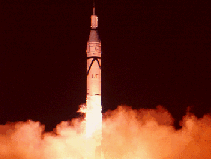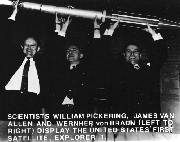 |
News conference following
the launch of Explorer 1;Click
here for a full size version.
|
Van Allen equipped the spacecraft with a Geiger counter, a device for detecting high-energy ions and electrons. The goal was to measure the intensity of cosmic rays, fast ions that come from space, and in particular its variation with distance from the magnetic equator. Van Allen hoped to learn from this about the low end of the cosmic ray energy range, particles too slow to penetrate the full thickness of the atmosphere and reach the ground.
Discovery of the Radiation Belt
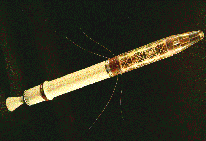 |
Explorer 1 spacecraft
Click here for a full size version.
|
Unlike the orbits of the Sputniks, that of Explorer 1 was quite elliptical and it rose to an altitude of about 2500 kilometers. Furthermore, since it had been decided to omit the spacecraft's tape recorder on the first flight, data could only be collected when Explorer 1 was within range of a tracking station, for at most a few minutes each time. The data were puzzling. At low points of the orbit the number of energetic particles was near the expected value, but at the high portions of the orbit none were counted at all.
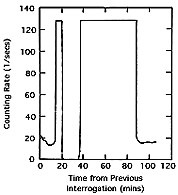 |
Trace of counting rate
of Explorer 3
|
Explorer 2 failed to orbit, but Explorer 3, launched March 26, was successful, and it did carry a tape recorder. Its trace of the number of counts was normal at low altitudes, then it rose rapidly to fill the transmittable limit of 128, but at the highest level it fell to zero. Laboratory experiments with similar counters confirmed that this was characteristic of extremely high counting rates, when the counter discharged so frequently that it could not properly recover between counts, yielding pulses too small to trigger the counting circuit.
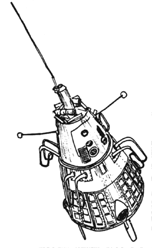 |
| Sputnik 3
|
Sputnik III, carrying more elaborate scientific instruments, was launched May 12 and confirmed the discovery. It was later realized that Sputnik II had also detected the belt at the highest part of its orbit, but that occured above Australia, where the USSR did not track it. The Australians did get the signal, but the USSR would not reveal to them the broadcast code. Further studies were conducted by Explorer 4 later that year (trapped radiation, history) and of course, by many spacecraft ever since.
Exploring Further
A web site with a picture of the Explorer-1 rocket and with links.
For more on the story of Explorer 1 and Sputnik, click here.
Click here for a web page devoted to James Van Allen, and here for his autobiography.
A commemorative article "Discovering Earth's Radiation Belts: Remembering Explorer 1 and 3" by Frank McDonald and John Naugle appeared in "Eos" 89, 23 September 2008, p. 361-3.
|
